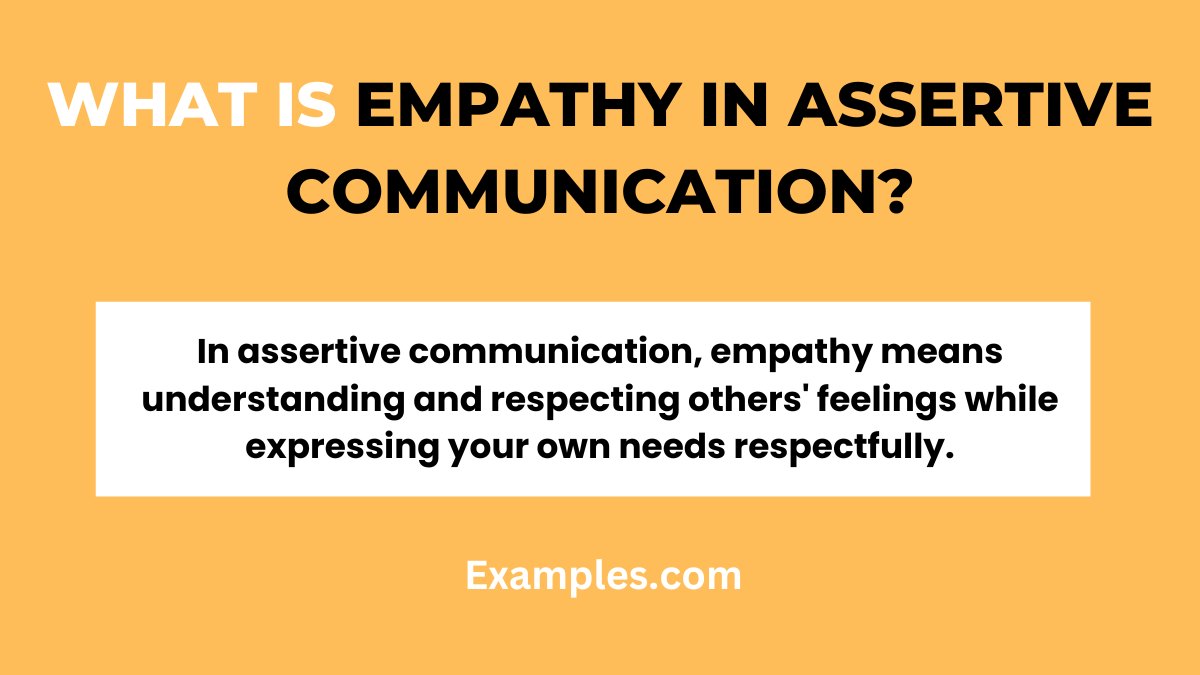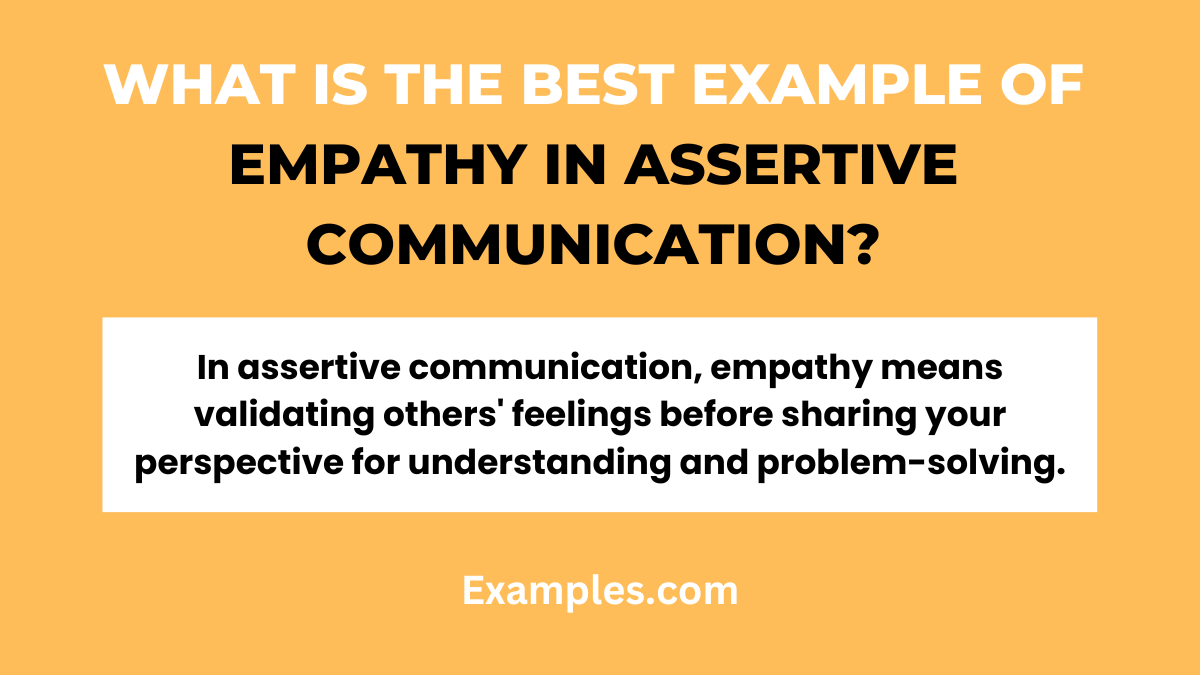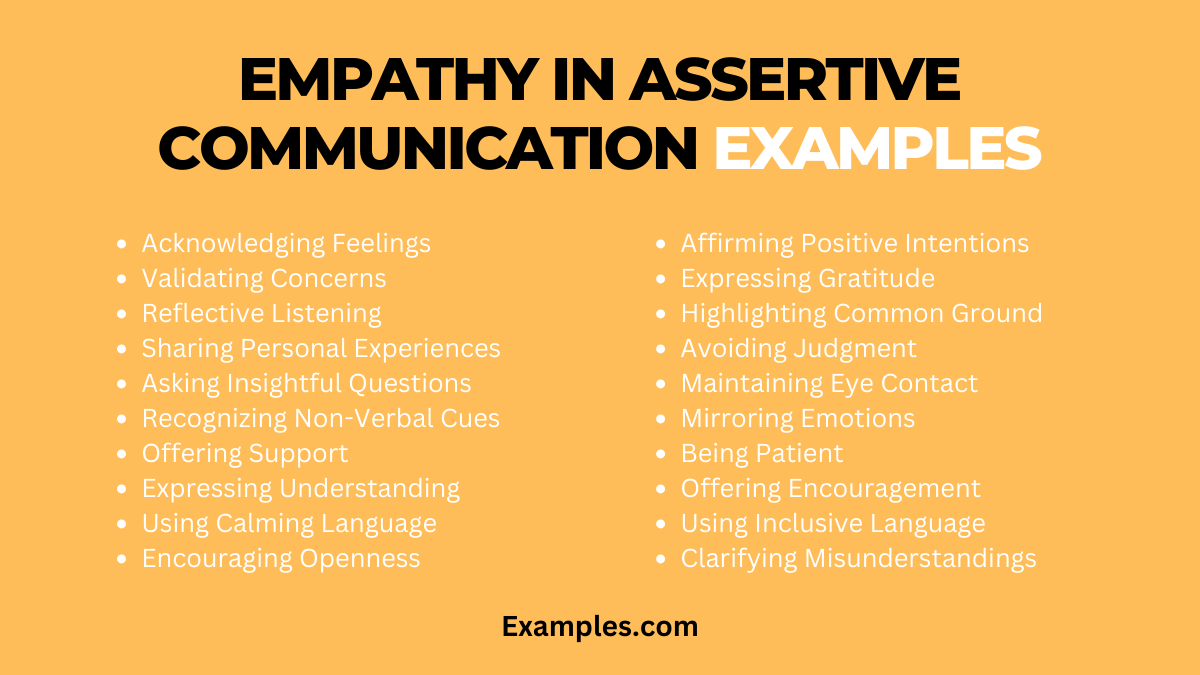19+ Empathy in Assertive Communication Examples
Empathy plays a crucial role in assertive communication, bridging understanding and respect. This comprehensive guide delves into how empathy, when combined with assertiveness, creates a powerful communication tool. Through practical examples, we’ll demonstrate how to effectively convey empathy while maintaining assertiveness. Understanding the feelings and perspectives of others can significantly enhance interactions, making them more effective and harmonious. By mastering Assertive Communication Examples with empathy, you can improve both personal and professional relationships.
What is Empathy in Assertive Communication?

Empathy in assertive communication involves understanding and acknowledging others’ feelings and viewpoints while expressing your own needs and opinions respectfully. It’s about finding a balance between being compassionate and maintaining your stance. This approach fosters a positive environment where both parties feel heard and valued.
What is the Best Example of Empathy in Assertive Communication?

A prime example of empathy in assertive communication is actively acknowledging and validating another person’s feelings before expressing your own perspective. For instance, if a colleague is upset about a heavy workload, you might say, “I understand that you’re feeling overwhelmed right now. Let’s discuss how we can adjust the workload to make it more manageable for you.” This approach demonstrates understanding and care while also addressing the issue at hand.
20 Empathy in Assertive Communication

Empathy in Assertive Communication involves understanding others’ feelings and perspectives while clearly expressing your own needs and opinions. This balance of sensitivity and assertiveness is crucial for effective, respectful communication.
- Acknowledging Feelings: “I understand you’re upset about the deadline. Let’s work together to find a solution that suits us both.”
Example: This demonstrates empathy by recognizing the other person’s emotions and offering a cooperative approach. - Validating Concerns: “I see why this issue worries you. How can we address it together?”
Example: Validating concerns shows you’re attentive to the other’s feelings, fostering a supportive conversation. - Reflective Listening: “It sounds like you’re feeling overwhelmed with this project. What can I do to help?” Example: Using reflective listening demonstrates empathy by mirroring back the emotion expressed.
- Sharing Personal Experiences: “I’ve faced similar challenges, and I understand it’s not easy. Let’s discuss possible solutions.”
Example: Sharing experiences shows empathy and creates a connection.

- Asking Insightful Questions: “How has this situation been affecting you?”
Example: This shows genuine interest in understanding the other person’s perspective. - Recognizing Non-Verbal Cues: “I notice you seem tense discussing this. Would you like to take a break and revisit this later?”
Example: Paying attention to non-verbal cues is a key aspect of empathetic communication. - Offering Support: “I’m here to help you through this. What support do you need from me?”
Example: Offering support directly addresses the other person’s needs, showing empathy and assertiveness. - Expressing Understanding: “I get why this matters to you. Let’s find a way forward that respects your concerns.”
Example: Expressing understanding blends empathy with a commitment to finding solutions. - Using Calming Language: “Let’s take this one step at a time. I’m here to listen and understand.”
Example: Calming language can de-escalate emotions and demonstrate empathy. - Encouraging Openness: “Feel free to share your thoughts. I value your input.”
Example: Encouraging openness invites the other person to express themselves fully. - Affirming Positive Intentions: “I know you’re coming from a good place. How can we align our goals?” Example: Affirming positive intentions reassures the other person of mutual respect.
- Expressing Gratitude: “Thank you for sharing your feelings. It helps me understand your perspective better.”
Example: Expressing gratitude for the other’s openness is a powerful empathetic gesture. - Highlighting Common Ground: “We both want the best outcome. Let’s focus on how we can achieve that together.”
Example: Finding common ground is a way to show empathy while maintaining assertiveness. - Avoiding Judgment: “I respect your viewpoint, even though we may see things differently. Let’s explore all options.”
Example: Avoiding judgment is crucial for empathetic assertive communication. - Maintaining Eye Contact: “I’m listening to you and value what you have to say.”
Example: Eye contact conveys attentiveness and empathy. - Mirroring Emotions: “I can sense your enthusiasm. It’s great to see you so engaged with this project.” Example: Mirroring emotions shows you are in tune with the other person’s feelings.
- Being Patient: “Take your time to express what you’re feeling. I’m here to understand.”
Example: Patience is a key element in empathetic communication, giving space for the other person to open up. - Offering Encouragement: “I believe in your ability to handle this. How can I support you?”
Example: Encouragement combines empathy with a positive, assertive stance. - Using Inclusive Language: “We’re in this together. Your challenges are important to me.”
Example: Inclusive language fosters a sense of unity and understanding. - Clarifying Misunderstandings: “Let me make sure I understand correctly. Are you saying…?”
Example: Clarifying misunderstandings promptly shows that you value accurate comprehension and empathetic engagement.

Importance of Empathy in Assertive Communication
- Enhances Understanding: Empathy in assertive communication bridges gaps, allowing individuals to understand others’ perspectives. By empathizing, one can more effectively communicate their thoughts without dismissing others’ feelings.
Example: Acknowledging a colleague’s challenging workload before discussing a shared project. - Builds Stronger Relationships: Showing empathy fosters trust and strengthens relationships, which is crucial in any team, especially in brand communication.
Example: A manager considering an employee’s personal challenges while assigning tasks. - Reduces Conflicts: Empathy helps in de-escalating potential conflicts. Understanding and acknowledging others’ emotions can lead to more harmonious interactions.
Example: A team leader recognizes stress in a team member and addresses it calmly. - Improves Customer Relations: In brand communication, empathy allows for a deeper understanding of customer needs, leading to better service.
Example: A customer service representative genuinely acknowledges a customer’s frustration and works towards a solution. - Encourages Open Communication: Empathy encourages open and honest dialogue, which is vital for effective brand communication.
Example: A marketer listens to feedback from the sales team to improve strategies. - Enhances Team Collaboration: Empathy leads to a more collaborative environment where everyone feels valued and heard.
Example: A project manager empathizes with the team’s workload and adjusts deadlines accordingly. - Promotes a Positive Work Environment: Demonstrating empathy contributes to a positive and supportive work culture, essential in brand communication teams.
Example: Colleagues offer support during a team member’s tough personal times. - Facilitates Problem Solving: Empathy allows for a more comprehensive understanding of problems, leading to more effective solutions.
Example: A creative director considers the team’s feedback in a new campaign.
How to Improve Empathy in Assertive Communication
- Active Listening: Focus on truly listening to others, understanding their point of view without interrupting. Example: During a meeting, listen attentively to each team member’s ideas before responding.
- Body Language Awareness: Use open and inviting body language to show you’re engaged and understanding.
Example: Maintain eye contact and nod during conversations. - Ask Open-Ended Questions: Encourage others to share their thoughts and feelings by asking questions that require more than a yes or no answer.
Example: Ask a colleague how they feel about a new brand communication strategy. - Validate Others’ Feelings: Acknowledge and respect the feelings of others, even if you don’t agree. Example: Express understanding when a team member feels overwhelmed.
- Reflect on Your Own Feelings: Understand your own emotions to better empathize with others.
Example: Recognize your frustration in a challenging situation and how it affects your communication. - Practice Mindfulness: Being present in the moment helps you to tune into others’ emotions.
Example: Focus on the current conversation, avoiding distractions. - Seek to Understand Before Being Understood: Prioritize understanding others’ perspectives before pushing your own viewpoint.
Example: In a dispute, first listen to the other side’s concerns. - Use ‘I’ Statements: Communicate your feelings without making assumptions about others.
Example: “I feel concerned about this deadline,” instead of “You’re making me stressed.” - Educate Yourself on Emotional Intelligence: Learn about emotional intelligence to improve your empathy skills.
Example: Read books or attend workshops on emotional intelligence in the workplace. - Practice Regularly: Like any skill, empathy improves with practice. Seek out opportunities to empathize with others in your daily interactions.
Example: Have regular check-ins with your team to understand their challenges in brand communication.
Incorporating empathy into assertive communication enhances mutual understanding and respect. It involves acknowledging others’ feelings and viewpoints, paving the way for more effective and harmonious interactions. By practicing empathetic assertiveness, individuals can navigate conflicts more gracefully, ensuring that their voice is heard while respecting others’ perspectives.



